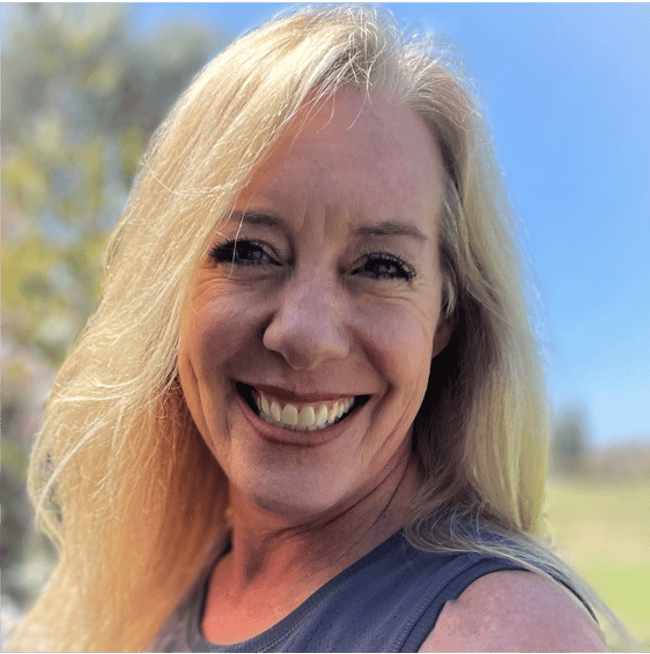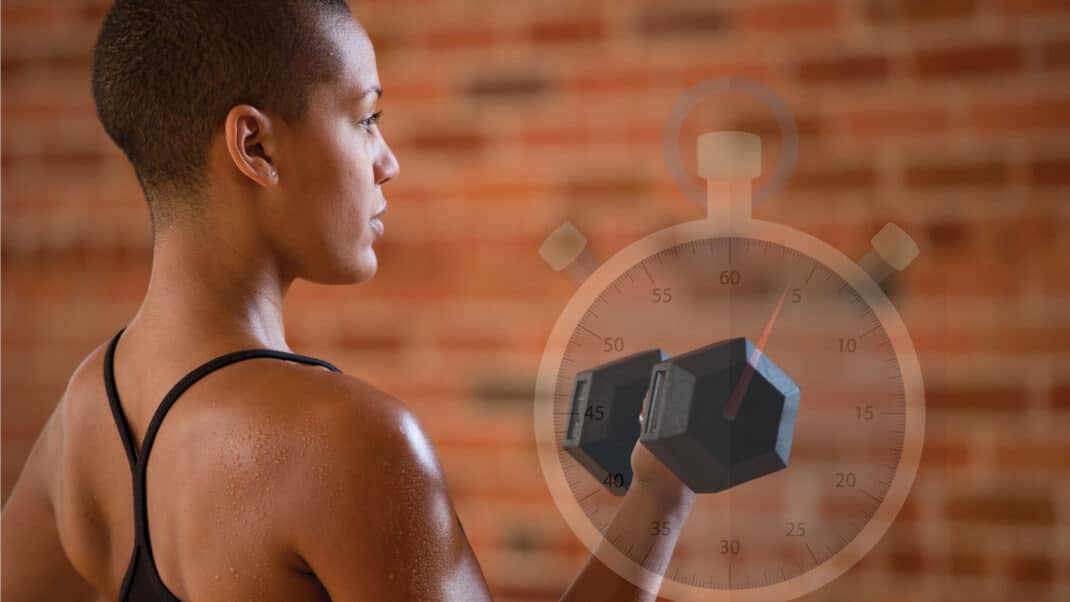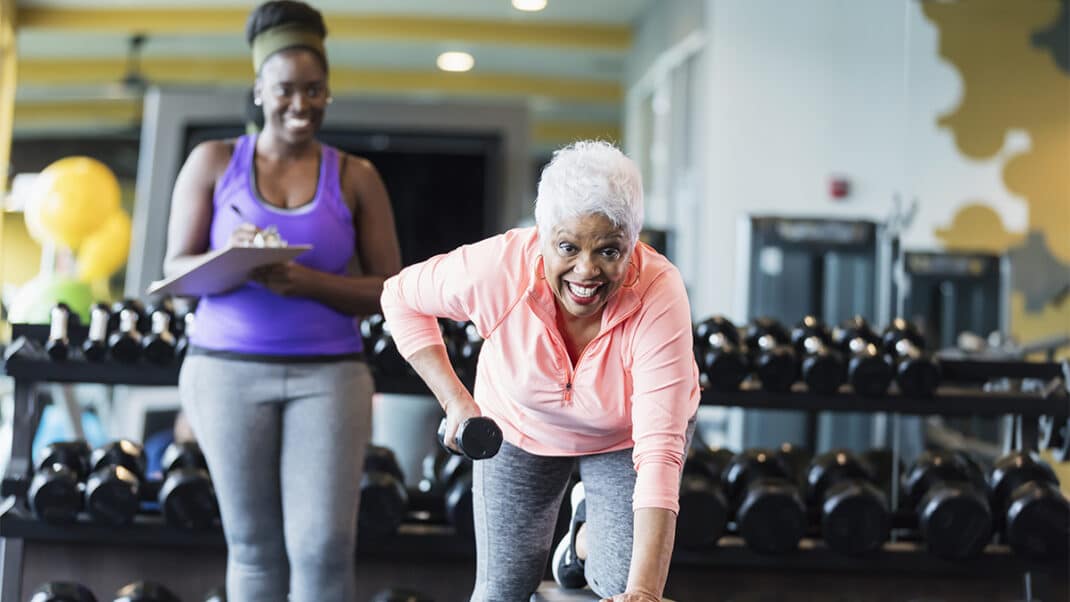Meeting the Challenge: Variety, Activity for All
Highlights of the 12th IDEA Fitness Programs & Equipment Survey
A major component of the fitness professional’s job is to inspire people to become more active and to continue a program of activity throughout their lives. As obesity and hyperkinetic disease rates continue to climb, we are constantly challenged as an industry to promote and motivate healthy living.
The 12th IDEA Fitness Programs & Equipment Survey shows that the fitness industry continues to offer such a range of activities that it is bound to be able to meet the needs of consumers, regardless of their age or physical condition.
The 225 IDEA business and program director members who responded to the survey can help us expand our viewpoints, allowing us to assist more people. These respondents report that, on average, 73% of their members/clients stay with the business for 1 year or longer. Let’s look at how these companies do it.
Who Is Using Your Facility?
% of respondents who currently serve these types of people:
| Apparently healthy | 99% |
| Those with chronic or temporary injuries | 78 |
|
Those with special medical needs (e.g., diabetes or coronary artery disease) |
75 |
| Amateur athletes | 69 |
| Children and teens | 60 |
| Those with physical disabilities | 57 |
| Professional athletes | 29 |
| Women only | 13 |
What Are We Doing With Our New Members?
According to the business and program director members surveyed, 37% of our facilities’ clientele are beginners. As in previous surveys, a high percentage of respondents (74%) replied that they offer classes and programs to attract inactive or new exercisers. Parks and recreation departments (100%), YMCA/YWCA/JCC facilities (94%) and corporate and hospital settings (93%) appear to lead the way in attracting inactive or new exercisers.
In the group exercise room, beginner-level classes in Pilates, yoga, step and indoor cycling are the most commonly reported formats for attracting and retaining new clients. Across all facilities, the most common types of programs offered to new clients free or at a discounted fee are fitness assessments (54%) and goal setting (50%); in fitness-only and multipurpose health clubs, 62% offer free or discounted personal training services. Jacqui Polz, MS, general manager of Cardinal Fitness in Darien-Westmont, Illinois, says that performing fitness assessments affords clients multiple opportunities to see how far they have progressed. “As clients progress, they may forget where they were physically and physiologically when they first started their program,” says Polz. “Repeat assessments show them how far they have come, which helps to keep them motivated and on track. Goal setting with clients allows time to set realistic expectations and design an appropriate program. Revisiting goals each time clients enter the gym can help remind them why they joined in the first place and keep them inspired.”
Attracting and Retaining New Clients
|
|
All |
Fitness-Only & Multipurpose Health Clubs |
Personal Training Gyms & Clients’ Homes |
YMCAs/YWCAs/JCCs* |
Yoga or Pilates Studios |
|
n (number) |
225 |
58 |
32 |
16 |
40 |
|
Classes/programs to attract inactive persons or new exercisers |
74% |
81% |
50% |
94% |
78% |
|
Free or discounted fitness assessments |
54 |
67 |
56 |
88 |
33 |
|
Free or discounted goal setting |
50 |
60 |
47 |
81 |
45 |
|
Free or discounted personal training |
38 |
62 |
25 |
50 |
30 |
* Small sample size of YMCAs/YWCAs/JCCs is not representative.
We Are Headed Outside!
We are moving beyond the walls of our facilities and taking clients outside to exercise. Since 2004, the percentage of respondents offering outdoor personal training sessions has increased from 26% to 60%, and the percentage offering outdoor boot camps has risen from 16% to 30%; outdoor group activities have seen an increase of 6 percentage points, to 50%, since 1999. Todd Durkin, MA, owner of Fitness Quest 10 in San Diego, believes that a successful program does not need to take place inside the four walls of your facility. “Outdoor sessions are easy to do,” he says. “We do not need fancy equipment to get great results. People are cooped up all day in an office; to have the ability to go outside and have clients exert themselves physically while enjoying the feel of open space, wind or sunshine is a big benefit to moving your sessions outside.”
Personal Training Is Still Number One!
Personal training once again ranks as the most frequently offered program (82%). Adult one-on-one training is still the most popular personal training format (80%), but the percentage of respondents offering sessions for 2 clients sharing has increased to 71%, while 3- to 5-client sessions have stabilized at 44%. Personal training gyms and in-home training are most likely to offer multiple-partners training. Fitness assessment ranks as the third most offered program (77%) in our industry.
The combination of personal training and fitness assessments when working with individuals is needed now more than ever. Our members are no longer just healthy individuals who want to increase their fitness levels: 78% of facilities have members with chronic or temporary injuries; 75% have members with special medical needs, such as diabetes, obesity or arthritis; and 57% have members with physical disabilities. As Cody Sipe, MS, co-owner of Miracles Fitness in West Lafayette, Indiana, points out: “Medically based fitness facilities have discovered that they have a fantastic ability to attract older adults with health concerns while also serving a wide variety of younger members. Thus, they have grown tremendously over the past 10 years.” The need to assess these unique members’ strengths, weakness and imbalances becomes even greater in order to provide the most appropriate exercise design.
Pilates and Yoga Fuse With Other Formats
The prevalence of Pilates and yoga in the fitness industry is still impressive, with 68% of survey respondents offering Pilates; 56% offering yoga; and the number of classes per week averaging 13. While the percentage of respondents offering Pilates has risen dramatically since 1999 (up from 19%), yoga has actually declined a bit, from 64%. The fusion of Pilates and yoga has increased slightly, with 38% now offering it compared with 31% in 2004; however 60% of the respondents who currently offer fusion options believe the format will grow.
This was the first year a mind-body fusion “write-in” category was included in the survey. Twenty-seven percent of facilities are offering classes of this type, among them unique offerings such as Pilates and BOSU® Balance Trainers, Pilates and tango, yoga and ballet, and yoga and stability ball. While it may not have the largest number of offerings just yet, fusion options rank top among the mind-body programs expected to grow (68%).
Small Equipment Keeps Clients Motivated
Small equipment continues its dominance; stability balls (85%), resistance tubing or bands (84%) and balance equipment (79%) are the three most frequently offered types of equipment. Since 1999, respondents using stability balls have increased steeply, from 52%, while those offering stability ball-based programs have risen from 39% to 54%. Balance equipment—such as the BOSU Balance Trainer, disks, wobble boards and balance boards—is now offered by 79%, up from 60% just since 2005. The increase in the use of stability balls and balance equipment may be the result of their varied uses. Stability balls, balance equipment, and resistance tubing and bands are seen in both the personal training and group exercise areas. These types of equipment are multifunctional and allow for creative movements that tax multiple systems of the body. In addition, this popularity could reflect the positive response of clients to new and interesting equipment, coinciding with fitness professionals’ excitement over teaching new skills.
While small equipment is in demand, cardiovascular and strength equipment has not been forgotten. Treadmills, elliptical trainers and recumbent cycles are offered by at least 60% of all surveyed companies, and stair climbers by 50%. A deeper look at the data reveals that the numbers for fitness-only and multipurpose health clubs are much higher: treadmills (93%); elliptical trainers (91%); recumbent cycles (86%); and stair climbers (79%). Fewer than 8% of Pilates and yoga studios offer these types of cardiovascular equipment. Most fitness-only and multipurpose h ealth clubs offer selectorized (pin-selected) machines (85%) and plate-loaded machines (83%), while 0% of yoga and Pilates studios provide this equipment.
Large Equipment: Going, . . . Going, . . . Gone?
|
|
All |
Fitness-Only & Multipurpose Health Clubs |
Personal Training Gyms & Clients’ Homes |
YMCAs/YWCAs/JCCs* |
Yoga or Pilates Studios |
|
n |
225 |
58 |
32 |
16 |
40 |
|
Elliptical trainers |
60 |
91 |
72 |
100 |
8 |
|
Recumbent cycles |
60 |
86 |
81 |
100 |
5 |
|
Stair climbers |
50 |
79 |
44 |
100 |
3 |
|
Treadmills |
65 |
93 |
97 |
100 |
5 |
|
Plate-loaded machines |
53 |
83 |
66 |
88 |
0 |
|
Selectorized (pin-selected) machines |
56 |
85 |
81 |
81 |
0 |
* Small sample size for YMCAs/YWCAs/JCCs is not representative.
Seniors Are Here, but Are We Paying Attention?
Seniors 55 years and older are the fastest-growing segment of the population and comprise the largest segment of the membership base within our facilities (29%). However, only 39% of respondents’ facilities offer classes geared specifically to the older adult, down from 47% in 1999. Sipe, a registered clinical exercise physiologist and IDEA contributing editor, believes the industry has been slow to incorporate senior-specific programs for many reasons, but mainly because it has considered older adults a fringe membership group. “[The industry’s] bread and butter has long been active adults in their 20s and 30s,” he said. “Because of this, most clubs really don’t understand seniors and therefore stereotype them one way or another. Instead of offering senior-specific programming that focuses on age, we will see the more savvy clubs offering ‘ senior-sensitive ’ programs that are really ageless. That is, by incorporating age-friendly qualities into their facility and within their staff, these clubs will begin to attract a larger diversity of both older adults and novice exercisers that don’t fit the typical ‘fit and beautiful’ mold.”
Working With Seniors
|
|
All |
Fitness-Only & Multipurpose Health Clubs |
Personal Training Gyms & Clients’ Homes |
YMCAs/YWCAs/JCCs* |
Yoga or Pilates Studios |
|
n |
225 |
58 |
32 |
16 |
40 |
|
Exercise for chronic conditions (e.g., diabetes, coronary heart disease) |
31 |
29 |
59 |
44 |
30 |
|
Seniors’ classes |
39 |
55 |
25 |
100 |
25 |
|
Water fitness |
27 |
41 |
6 |
75 |
0 |
* Small sample size of YMCAs/YWCAs/JCCs is not representative.
Group Exercise Has Something for Everyone!
In general, most formats within the group exercise area have experienced a decline over recent years. For example, step aerobics programs have decreased from 71% to 44% since 1999 and traditional aerobics have fallen from 72% to 47% since 2000. These drops are most likely due to the diverse offerings on the schedule, as the average number of people attending a group class (15) has changed very little over the past several years, and the average number of classes offered per week has increased from 29 to 35 over the past year.
With over 30 types of classes on this year’s survey, it’s clear the group exercise room has much to offer its participants. The most frequently offered group exercise classes are strength training (74%); Pilates (68%); core conditioning (65%); abdominals (62%); and yoga (56%). While most formats have experienced a decline in order to make room on the schedule for more diversity, core-conditioning classes (+4 percentage points), indoor boot camp (+8) and dance-based classes (+11) are showing growth.
Pilates and Yoga Studios Are on the Rise
Yoga and Pilates studio business and program director members make up the highest percentage of respondents to this year’s survey. They represent 18% of the total, up from just 8% in 2006. This shift in categories may influence some sections of the survey; IDEA will report on these differences in future survey articles.
Looking to the Future
What have the survey respondents told us about the evolution of the fitness industry? Importance is placed on simplicity for gaining strength. With boot camps using little equipment, the shift from large to small equipment in the gym, and even mind-body classes relying heavily on body weight, we are demonstrating that it doesn’t take large, expensive tools to help people become fit.
The need for more education among fitness professionals has become a necessity because more and more of our clientele are in postrehabilitation. As the prevalence of disease in North America continues to climb, we need to shift our thinking from exercising for a desired body type to exercising for health. To address the importance of health, fitness assessments are on the rise, and fitness professionals must know how to interpret the results.
The quality of instructors or personal trainers plays a large part in clients’ results and, ultimately, client retention. As trainers embrace the challenge of training more than one person at a time, and group exercise instructors take on many new formats, are fitness professionals fully prepared? Does proper instructor training or group choreography suffer from the vast number of options consumers seem to demand?
Instructor resources for continuing education are certainly not lacking in the industry. Hopefully, knowledgeable instructors and a wide array of strength and cardio activities are available to all clients as they seek to stay motivated and to lead an active, healthy lifestyle. Are you and your staff ready for these challenges?
Jan Schroeder, PhD, is an associate professor in kinesiology at California State University, Long Beach.
Karlie Friesen is currently finishing her master’s degree in exercise physiology at California State University, Long Beach.
10 Programs With Growth Potential
The 10 programs most predicted to grow by respondents who offer them are not always the most popular activities. Fewer than one-third of them (personal training, Pilates and core-conditioning classes) are among the top 10 programs offered. Yet respondents are confident that all these activities will grow, even when very small minorities offer them.
|
|
Yes, I Offer This* and . . . |
I Believe It Will Grow** |
|
Lifestyle coaching |
27% |
72% |
|
Online client reminders and information |
32 |
68 |
|
Mind-body fusion |
27 |
68 |
|
Pilates |
68 |
64 |
|
Seniors’ classes |
39 |
63 |
|
One-on-one Pilates or yoga training |
48 |
61 |
|
Kids’ fitness (classes or after-school camps) |
33 |
61 |
|
Personal training (adult, one-on-one) |
80 |
61 |
|
Pilates and yoga fusion |
38 |
60 |
|
Core-conditioning classes |
65 |
59 |
* % of IDEA business and program director members offering the activity.
** % of those who offer the program.
25 Most Frequently Offered Programs
| personal training (combined) | 82% |
| personal training (adult, one-on-one) | 80 |
| fitness assessment | 77 |
| strength training in group (combined) | 74 |
| personal training (2 clients share) | 71 |
| Pilates | 68 |
| stretching and/or flexibility | 68 |
| strength training (individual, nongroup) | 67 |
| core-conditioning classes | 65 |
| abdominals | 62 |
| outdoor personal training sessions | 60 |
| clinics on special topics | 58 |
| strength training (group, with background music) | 58 |
| yoga | 56 |
| personal training (youth, aged 18 or younger, one-on-one) | 55 |
| stability ball-based programs | 54 |
| community outreach | 51 |
| outdoor group activities | 50 |
| circuit classes | 48 |
| one-on-one Pilates or yoga training | 48 |
| small-group classes (8 people or fewer) | 48 |
| aerobics (includes high-impact, low-impact, mixed impact) | 47 |
| nutrition assessment | 45 |
| personal training (3-5 clients share) | 44 |
| nutrition coaching | 44 |
25 Most Frequently Offered Types of Equipment
| stability balls | 85% |
| resistance tubing or bands | 84 |
| balance equipment (e.g., BOSU® Balance Trainers, disks, wobble boards, balance boards) | 79 |
| barbells and/or dumbbells | 78 |
| foam rollers and small balls | 72 |
| medicine balls | 71 |
| yoga mats and equipment | 70 |
| steps and platforms | 66 |
| treadmills | 65 |
| weighted bars | 64 |
| pulley equipment | 62 |
| elliptical trainers | 60 |
| recumbent cycles | 60 |
| upright cycles | 56 |
| selectorized (pin-selected) machines | 56 |
| plate-loaded machines | 53 |
| stair climbers | 50 |
| Pilates equipment | 44 |
| indoor cycles for classes | 38 |
| boxing equipment | 29 |
| water fitness equipment | 28 |
| nutrition analysis software | 19 |
| computer workout tracking | 11 |
| Gravity® trainers | 9 |
| pneumatic machines | 7 |
Jan Schroeder, PhD
Jan Schroeder, PhD, is a professor and past chair of the department of kinesiology at Long Beach State University. She coordinates and teaches in the fitness and integrated training undergraduate program and has written 60+ articles on exercise physiology/fitness. She is also a certified group exercise instructor who teaches weekly in the private sector. Schroeder is the recipient of the 2021 IDEA Fitness Leader of the Year Award.






